#literature theory
Text

Hate presentations for projects, why can’t we just start to do the project itself already.
But the Tchai Ovna teahouse made it more bearable.
22/11/2022
#studyblr#study#studying#studyspo#literature#literature theory#study motivation#studyspiration#study blog#presentation#essay writing#college essay#film studies#tea house#study with me#post moderism#college#university#uniblr#uni studyblr#literature studyblr#literature student#literature major#university studyblr#university struggles#university student#uni struggles#uni student#uni studyspo#study space
29 notes
·
View notes
Text
Book Review: Ways of Seeing by: John Berger
You painted a naked woman because you enjoyed looking at her, put a mirror in her hand and you called the painting “Vanity,” thus morally condemning the woman whose nakedness you had depicted for you own pleasure.Ways of Seeing – John Berger
Initial Thoughts: When I was finishing up my English Literature degree, I decided to take a class called “Literature Theory.” It was considered to be the…

View On WordPress
#art#Book#Book Blog#Book Blogger#Book Review#John Berger#Literature#Literature Theory#Philosophy#review#Ways of Seeing
8 notes
·
View notes
Text
look, I know I've talked about this essay (?) before but like,
If you ever needed a good demonstration of the quote "Any sufficiently advanced technology is indistinguishable from magic", have I got an exercise for you.
Somebody made a small article explaining the basics of atomic theory but it's written in Anglish. Anglish is basically a made-up version of English where they remove any elements (words, prefixes, etc) that were originally borrowed from romance languages like french and latin, as well as greek and other foreign loanwords, keeping only those of germanic origin.
What happens is an english which is for the most part intelligible, but since a lot everyday english, and especially the scientific vocabulary, has has heavy latin and greek influence, they have to make up new words from the existing germanic-english vocabulary. For me it kind of reads super viking-ey.
Anyway when you read this article on atomic theory, in Anglish called Uncleftish Beholding, you get this text which kind of reads like a fantasy novel. Like in my mind it feels like it recontextualizes advanced scientific concepts to explain it to a viking audience from ancient times.
Even though you're familiar with the scientific ideas, because it bypasses the normal language we use for these concepts, you get a chance to examine these ideas as if you were a visitor from another civilization - and guess what, it does feel like it's about magic. It has a mythical quality to it, like it feels like a book about magic written during viking times. For me this has the same vibe as reading deep magic lore from a Robert Jordan book.
#off topic#literature#language#linguistics#science#science history#science fiction#fantasy#physics#atomic theory#anglish#chemistry#robert jordan#the wheel of time#uncleftish beholding
42K notes
·
View notes
Text

Caitlin Conlon, "The Surrender Theory"
#writing#writerscommunity#women writers#writers and poets#writers on tumblr#creative writing#literature#writer things#writers#quotes#books and libraries#poets on tumblr#the surrender theory#caitlin conlon
3K notes
·
View notes
Note
Do you know why dogs do that little exhausted sigh when they lie down even when they haven't really done anything that particular day?
I, too, make exhausted little sighs when I flop down and am suddenly extremely comfy!
But, okay, here's what super interesting. I didn't want to just give you a flippant answer, so I started looking up if sighing is a behavior in other species than humans. Because it's always worth keeping an eye out for accidental anthropomorphism. Turns out? The science on sighing is fascinating. Stay tuned for intense nerding out, and maybe a bit more of an answer.
First off, we gotta know what a sigh is.
"The sigh is a deep augmented breath with distinct neurobiological, physiological, and psychological properties that distinguish it from a normal eupneic breath. Sighs are typically triggered by a normal eupneic breath and are followed by a respiratory pause, which is referred to as 'postsigh apnea.'"
In non-jargon, that definition means sighs are a deep breath with a different pattern to it than normal, easy, regular breathing. "Augmented breaths" are frequently used as a synonym for "sighs", and the best definition I found is that "they comprise prolonged inspiration and increased tidal volume followed by a respiratory pause and several seconds of faster breathing. So a longer than normal inhale where you take in more air than normal, then an exhale, and then pause before breathing in again. Oh hey, look, I found a graph!

The graph is super well labeled, but just to be clear: each cycle of the red line is a normal breath, where what's being tracked is the movement of the chest wall. The part where the vertical blue bar is, that's the cycle with a sigh. The red line spikes really high (during inspiration, or breathing in) at that blue patch, and for longer than the normal period of a breath. See how it's almost like two inhales on top of each other - a normal slope and then another upward spike? That's the "augmentation" of the normal breath, almost a double inhale without breathing out in-between. Then, after the red line drops (on the exhale) there's a flat bit. That's the respiratory pause, which the period after the sigh where you wait before you inhale again.
Apparently people have been tracking sighing scientific for like, over 100 years. The first record of it in academic literature was in 1919. And we know some really cool stuff. All humans sigh spontaneously. Even babies sigh! They do it every few minutes, whereas it's less frequent but still pretty regular in adults: one study found about once every five minutes, or twelve sighs an hour.
Okay, but why do we sigh? We only sort of know, because there's a bunch of different things that have to be studied to answer that question. The direct physiological aspect of it is the most well known at this point. You've got lots of little sacs lining your lungs, called alveoli, that facilitate gas transfer from the air you breathe into your blood. They make sure oxygen goes in and carbon dioxide gets breathed out. But sometimes they collapse and deflate, which prevents them from doing their job. When you do a big sigh, the air quantity in your lungs ends up being double that of normal, which inflates them again. So sighing is a way of doing lung maintenance, in a sense.
But there's so much more going on when you sigh than just that! This is the stuff researchers are still working on. They've got some pretty solid conclusions to start, but they're very emphatic that there's a ton more to learn.
Basically, the main hypothesis right now is that sighing functions as a "reset" for your internal state when it's out of balance. People sigh more when they're acutely anxious or stressed, are anticipating a negative outcome like a shock or seeing a negative image, or have chronic anxiety, PTSD, or panic disorders. Higher sigh frequency is also associated with pain: people with chronic low back pain sigh more, and how much they do correlates with how high their pain rating is at the time!
Another aspect of sighing is that it's frequently associated with periods of relief. Studies have noted that people sigh when they're able to relax following tension, like if they're interrupted while trying to do something really mentally taxing, when they finish a task that took a lot of attention for a long time, or if a negative stimulus stops/goes away. The reason behind that is actually thought to be why people sigh so much when they're upset or in pain: sighing doesn't just signal relief, but actually cause it! Some studies have found that people experience a temporary reduction in muscle tension right after a spontaneous sigh. (Unfortunately, that doesn't seem to also happen when you sigh on purpose.)
Sighing is also thought to facilitate behavioral and emotional transitions. The frequency at which someone sighs changes even just when they transition from sitting to lying down. People frequently sigh right before they fall asleep or start to wake up. One study found that people sigh more frequently when they go from a situation of being unable to anticipate what's next to a situation where they know what the outcome will be - regardless of if that outcome is going to be negative or positive! That led the researchers to hypothesize that sighing functions as an emotional reset from states of high internal arousal (a word which here means "the state of feeling awake, activated, and highly reactive to stimuli.") So sighing might not just bring relief when something really intense ends, but it might also help people prepare for upcoming stress.
Basically, researchers think that sighing may contribute to what they call "psychophysiological flexibility." That means that sighing helps keep someone in a physiological and emotional state that matches the situation they're in, and helps the body and mind adapt quickly when something changes. They noted that these types of transitions may involve "anticipatory, activation or recovery responses." In other words: they think spontaneous sighing is relevant not only when you're worried about encountering a leopard in the bush, but when you have to hide from the leopard you tripped over, and then also when you're calming down after the leopard got bored and left.
There's a whole bunch of research left to do about how exactly spontaneous sighs do what they do, but there's also a whole other aspect of the behavior that hasn't really been studied yet: their social function! In humans audible sighing is a salient social signal. (The researchers said the part of the paper addressing this that it is a "lay belief" that sighs have a "communicative function to convey emotions," which makes the whole thing feel like it was written by aliens observing humans from afar). But they did note that sighs for social communications may be totally different from other types of sighs, since the exhalation is often very exaggerated and doesn't always occur in tandem with that "augmented" inhale pattern that spontaneous sighs have.
Okay. So. I've been a nerd forever, but what about doggo sighs? Why do they occur? Obviously, the research doesn't give us a direct answer. The majority of the behavioral / situational research on sighing has been done on people, not animals. But it's pretty well documented lots of animals sigh (it might even be all mammals, I just don't have a citation for that). And some of the studies that have been done on animals indicated that they, too, sigh in relief when negative situations end or unpleasant stimuli go away.
Let's go back to my joke at the beginning of this book I've written. My first instinct was to be like "who doesn't sigh in relaxation when they finally get a chance to rest their bones?" That totally matches what's in the research: getting a chance to rest after activity is often both a behavioral transition and an emotional one, and if there's any physical discomfort being experienced, physical rest is often is a relief.
It seems fairly probable that dogs sigh when they lay down for at least one of those reasons. I can't prove that hypothesis, but it tracks with what the science says so far. The situation you described meets the main identified criteria for sighing: there's the physical transition of laying down, the behavioral/emotional transition of being ready for a period of low/no activity, and the possible relief of pain or discomfort that comes with laying down. We don't have any any evidence (that I was able to find) of species that sigh for other reasons, or sigh in situations that don't meet those criteria. We don't know for sure that this is accurate - this isn't fact, simply my educated guess. But since sighing seems to help muscles relax and relief discomfort, it seems reasonable to me that a good old sigh after the relief of laying down would make the transition to a resting state feel even better.
Sources:
Effects of the hippocampus on the motor expression of augmented breaths
Brainstem activity, apnea, and death during seizures induced by intrahippocampal kainic acid in anaesthetized rats
The Integrative Role of the Sigh in Psychology, Physiology, Pathology, and Neurobiology
Sigh rate during emotional transitions: More evidence for a sigh of relief
The psychophysiology of the sigh: I: The sigh from the physiological perspective
The psychophysiology of the sigh: II: The sigh from the psychological perspective
Affect Arousal
UCLA and Stanford researchers pinpoint origin of sighing reflex in the brain
#science!#dog behavior#sighing#sighs#I want to emphasize this is a hypothesis based on the existing body of research and that I am not an expert in this field#there are times where it is reasonable to look at the existing literature and create theories based on a synthesis of their findings#but this is not something to repeat as known fact#and that differentiation is extremely important in this sort of forum
3K notes
·
View notes
Text

— Richard Siken, Boot Theory
[text ID: A man takes his sadness and / throws it away / but then he’s still left with his / hands.]
8K notes
·
View notes
Text
the look all the blue haired communist give you when they try their “i’m a non-abled intersex trans woman suffering from a plethora of diseases” excuse to get out of labour :

Why are these people, those who do no or refuse hard or meaningful labour, the face of these economic revolutionary parties?
#socialism#communism#feminism#feminist#feminist literature#radical feminism#radical feminist theory#terfblr#trans exclusionary radical feminist#radical feminists please touch#radical feminist community#radical feminists do interact#socialist revolution#socialist politics
253 notes
·
View notes
Text

SPECIAL ANNOUNCEMENT !!!
i’m illustrating and writing a WEBCOMIC, titled CHAOS THEORY.
chaos theory is a (very) queer, coming-of-age drama that follows a young man growing up in the italian mob in modern day NYC. he’s extremely disillusioned with his day to day antics, even moreso when he finds the ghosts of his past and the skeletons in his closet catching up to him.
i will be announcing where it’ll be published in the near future, as well as posting the first full chapter for free. i’ve been working on this story for a LONG time now, and am deep in draft work. i’m very excited to share this with you guys!!!
#webcomic#bookblr#literature#fruitgravy#digital art#procreate#aesthetic#illustration#character art#character design#oc#original character#moonie’s ocs#chaos theory#cover art#comic#comic cover#comics#original comic#art#artists on tumblr
1K notes
·
View notes
Quote
Sometimes the hardest things in life are the things we have to do. And even when we feel it’s right, I never want to hurt you.
Juliana Theory
#Juliana Theory#motivation#quotes#poetry#literature#relationship quotes#writing#original#words#love#relationship#thoughts#lit#prose#spilled ink#inspiring quotes#life quotes#quoteoftheday#love quotes#poem#aesthetic
120 notes
·
View notes
Text
"The knife is a weapon of the Other"


"The emerging martial art of Bartitsu, appearing in middle-class magazines during the Boer War, was the encapsulation of British civilian gallantry. Yet Bartitsu would have slid into obscurity had it not been for its curious appearance in the Sherlock Holmes canon. The final showdown of the ‘duel’ between Holmes and Moriarty is a wrestling match between two Victorian masterminds. When Holmes returns to London he tells Watson that he and Moriarty went to battle at the Reichenbach Falls unarmed. Holmes managed to ‘slip through’ Moriarty’s grip as he possessed ‘some knowledge’ of ‘baritsu, or the Japanese system of wrestling’, adding that the art had on occasion been useful to him.
Founded in the 1890s by an Anglo-Scottish engineer, Edward William Barton-Wright (1860–1951), Bartitsu was a synthesis of British boxing, French la savate (kickboxing) and Japanese jujitsu. Barton-Wright tapped into the need for a bourgeois form of self-defence, something which he could promote as being British and yet was also exotic and refined.
The principal aim of Bartitsu’s promoters was ‘to provide a means whereby the higher classes of society may protect themselves from the attacks of hooligans and their like all over the world’. These urban gangs were a new form of folk devil, descendants of the mid-Victorian-era garotter. While they were armed with clubs, knuckles, iron bars and leather belts, it is doubtful that they carried firearms. Nevertheless, the press did represent the hooligan as a threatening presence.
Perhaps the scares promoted the growth of a burgeoning culture of ‘British’ self-defence which avoided the aggressive and increasingly unmanly action of using a firearm against a ruffianly lower-class opponent equipped only with basic weapons.
Barton-Wright follows a literary tradition when he presents his martial art as a British form of self-defence. Pierce Egan’s well-known self-defence manual was supplemented with a word on the ‘Englishness’ of physical heroism, arguing that ‘Englishmen need no other weapons in personal contests than those which nature has so amply supplied them with’. In 1910 the former lightweight boxing champion Andrew J. Newton said in his manual Boxing that ‘the native of Southern Europe flies to his knife’, whereas the ‘Britisher […] is handy with his fists in an emergency’. Elsewhere it was maintained that the ‘Italian, Greek, Portuguese, or South American’ ‘give preference to the knife’ while the Englishman extols boxing. For Barton-Wright, British boxers ‘scorn taking advantages of another man when he is down’, while a foreigner might ‘use a chair, or a beer bottle, or a knife’ or, ‘when a weapon is available’, he might employ ‘underhanded means’. The views of these articles reappear in a later self-defence manual of 1914, where it is argued that Britons ‘live in a country where knife and revolver are not much in evidence’. This statement about the low number of firearms and edged weapons can be read as an attempt to extol British virtues and is not necessarily representative of reality. The knife is a weapon of the Other. Barton-Wright’s view that English practitioners of Bartitsu are principled men is reflected in the Sherlock Holmes canon, where Holmes never uses a knife, although his enemies, whether foreign or British, do so at times."
— Emelyne Godfrey, Masculinity, Crime and Self-Defence in Victorian Literature (Palgrave Macmillan, 2013) (very abridged)
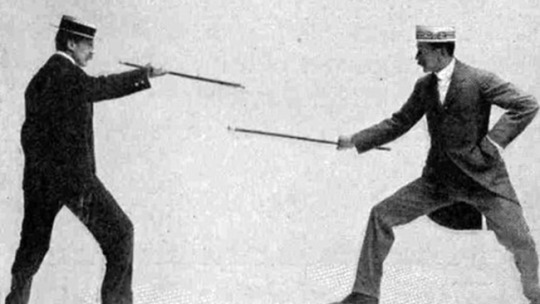
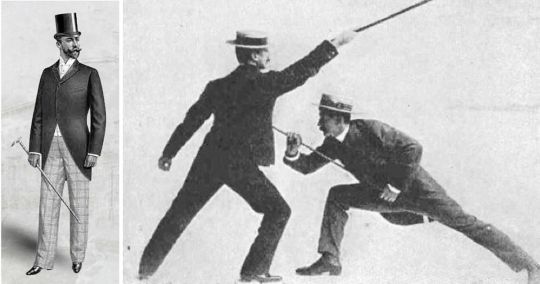
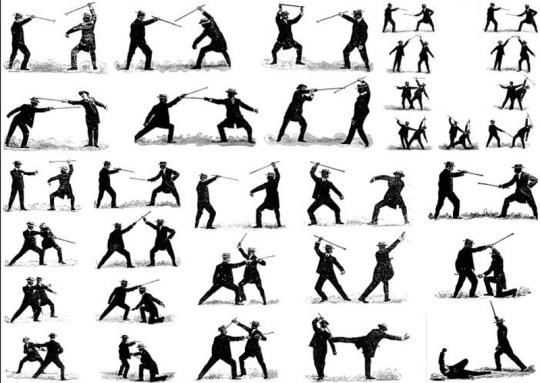
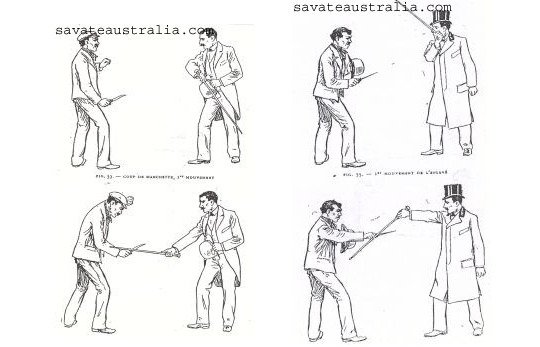
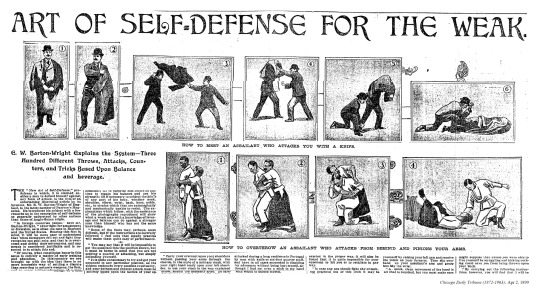
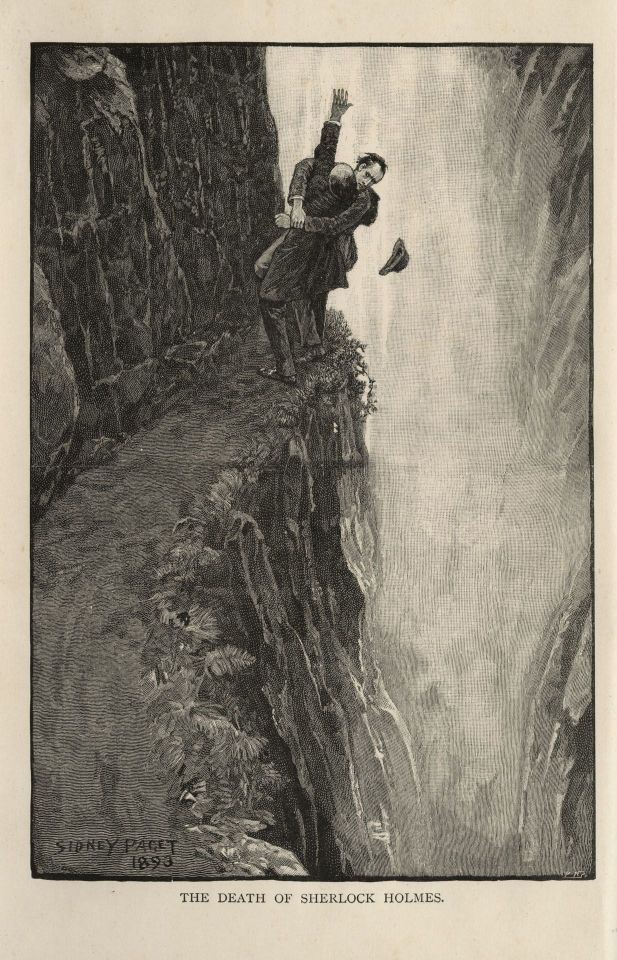
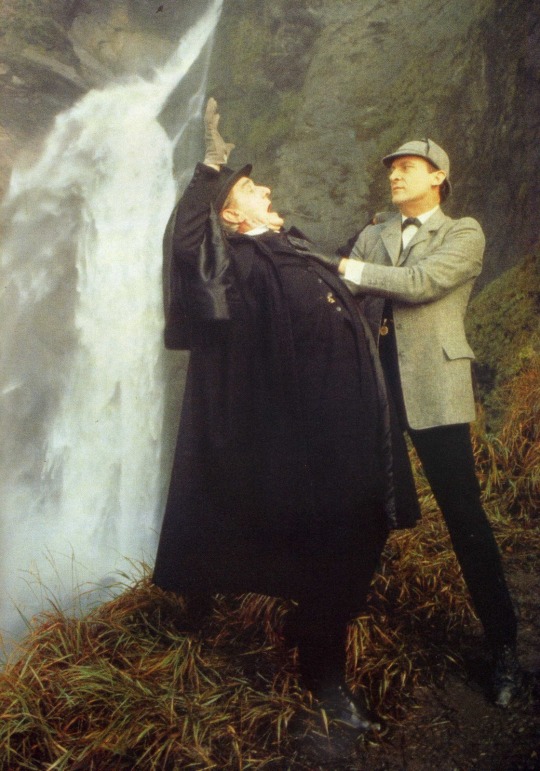
#Masculinity Crime and Self-Defence in Victorian Literature#Emelyne Godfrey#theory#how to stab#sherlock holmes#arthur conan doyle#bartitsu#rogues in fiction#moral panics#dishonour on your cow
596 notes
·
View notes
Text
Edward Said
I always struggle to decide which of Edward Said's works to recommend first, so:
Orientalism
The Question Of Palestine
Culture And Imperialism
See also:
The Politics of Dispossession (PDF unavailable)
Peace And Its Discontents (PDF unavailable)
#his writing on music is also incredibly rich and interesting btw#Edward Said#postcolonial literature#postcolonial theory#postcolonial#postcolonialism#postcolonialist#postcolonial reading#🍉#Palestine#free Palestine#original
147 notes
·
View notes
Text
The animators were Kurahi shippers and you can’t change my mind: exhibit A
Enthusiastic reading-too-much-Kurahi-but-not-really into the animation~

From episodes 68 & 69, “Setting the Trap” and “The Power of Taboo”
So anyone creative that writes or draws or what have you can tell you that everything actually is intentional, and by that I mean, every word you pick to write and every design or illustration you make is a choice. We make choices, we decide, and then those things are up for interpretation.
All of that is to say: I think these animators were kurahi shippers or something man, there's an interesting visual in these two episodes that happens repeatedly. pls don’t judge me for my intense meta bullshit that’s about occur lol
When Kaito is about to take Hiei’s soul, he looks down at him, and we see a violet colored flash in his glasses.
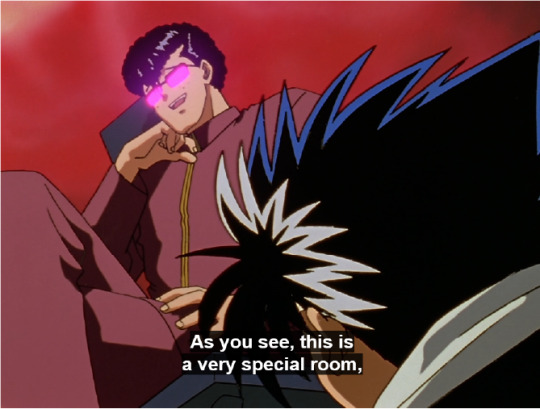

After he takes his soul, it’s encased in that same shade of purple. We know from earlier episodes and later on when their souls are returned that souls don’t have a color, they’re just white/translucent, so that means Kaito color-coded the souls by his own volition. Purple for Hiei, blue for Botan, and yellow for Kuwabara.

What’s interesting is…this purple color/flashes of purple light don’t go away. They’re present during Kurama’s battle of wits with Kaito and their negotiation of the terms.
Now someone might say, “well Hiei’s soul is positioned on the rightmost side and the purple visually stands out better, it makes sense it would show, it doesn’t mean anything.” And perhaps they’re right, but I don’t think so.
Again, these things are intentional choices, regardless of whether or not what they mean is agreed upon. They chose to make Hiei’s that color, they chose to position it to the side, and they chose to use it for this visual effect.
Most important to note: this visual choice is only done for Hiei’s color, purple. There’s no ambient light in the room and it’s the exact same color, ergo very intentionally done. They don’t rotate between colors, they never show flashes of blue or yellow or all three—it’s only purple.
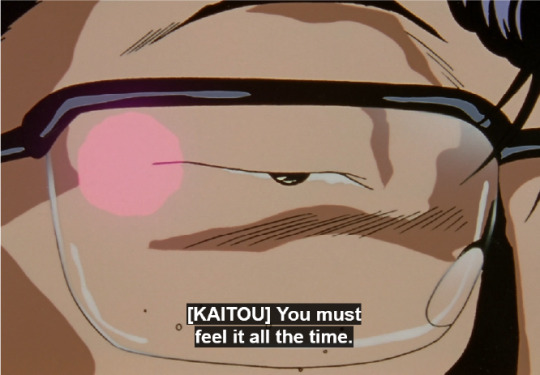
⬆️ here for example. Arguably we should be able to see the blue and yellow reflected in his glasses, too. But we don’t. Just that fuchsia color. Just Hiei’s soul.
So what does it mean (to me)?
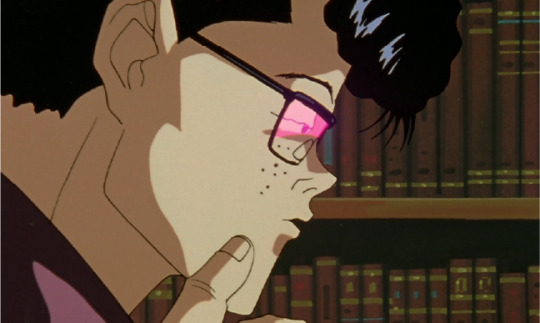
I think it means that Hiei is most important to him, and somehow Kaito has clocked that. Hiei’s soul is the one reflected in Kaito’s glasses while they negotiate the rules of their game.
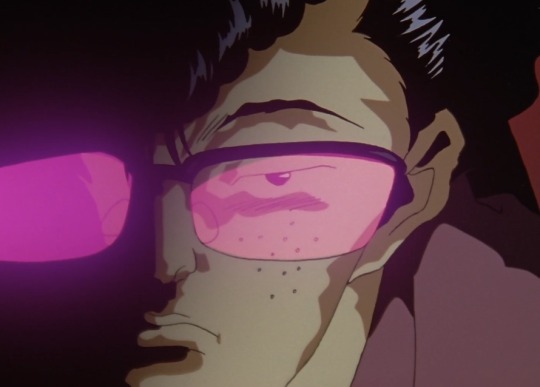
And it’s only reflected/shown in his eyes when he’s looking at kurama (other than Hiei prior to the soul stealing!), not anywhere in the room, which is what makes me think that Kaito knows how significant the relationship between Kurama and Hiei is. He (literally in a visual sense) can see it. These flashes happen the most/almost exclusively during this scene—as if he’s dangling Hiei’s soul specifically to bait Kurama into playing his game.

It’s symbolic of how meaningful the relationship is to him, because it’s shown like it’s the bargaining chip to make the game happen. When he taunts Kurama that he still hasn’t made his choice, the reflection is there again. The significance is only emphasized by the fact that it doesn’t happen with anyone else’s soul/color.
Additionally, I like that Kaito’s hand is hovering over Hiei’s soul when Kurama threatens to erase him from reality. I don’t think this is strong evidence or anything, but it compliments my theory here quite nicely lol.
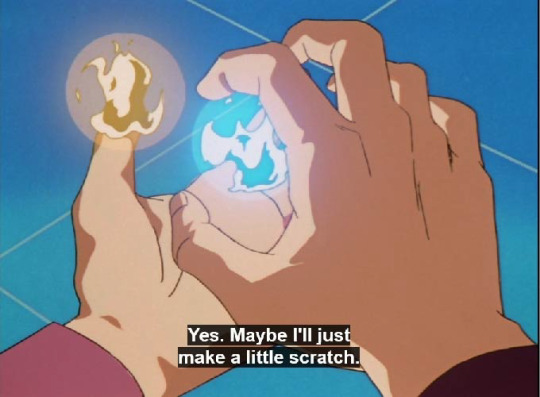
Bonus (aka this doesn’t really have evidentiary support but hey it rolls with this pretty well): look at how mad Kurama is after Hiei’s soul is taken. Angry husband.

TLDR: they knew wtf they were doing with this man YOU CANT MAKE ME BELIEVE OTHERWISE
#yu yu hakusho#yyh#kurahi#yyh meta#yyh headcanons#musings.txt#Hiei#kurahiei#Kurama x Hiei#fan theory#yuu kaito#i miss literature class#can you tell
161 notes
·
View notes
Text
one of my friends made an absolutely brilliant observation on quesadilla island and purgatory,
for a while now i know a lot of people even here have theorized and talked about the similarities of quesadilla island and the lotus eaters mythical story - with there even being quite notable appearances of lotuses, like on quackitys ticket.
now, in homers odyssey, of which the story of the lotus eaters comes from, where do they go after getting off of the island of lotus eaters? the lush island near cyclopes. where polyphemus, a cyclops, resided and tried to seal odysseus and his men away for eating. and to escape polyphemus, odysseus, in some retellings, calls himself "nemo", a greek word for "nobody" (flashbacks to point nemo...) and then stabs the cyclops in the eye to escape.
basically,
the islanders have left the island of lotus eaters (quesadilla island) and gone to the island of polyphemus (purgatory), and they are symbolically trapped by the cyclops and are being eaten. this is further supported by the fact the big being residing over the islands is singular eye and the fact there are little cyclopses running around the island.
and the islanders need to stab the cyclops in the eye to escape. its the only way.
do you get it!!! do you get it!!! this is actually an insane revelation to me as a huge mythology lover! im so giddy over this i had to share.
#needed to share my friends observation#because its SO COOL when you realize it#qstudios writing team you have my heart for all these literature references holy shit#qsmp#qsmp theory#qsmp purgatory#we'll make sure a tear-jerking invitation arrives to your very doorstep | qsmp#qsmpattackz#splatattackz
149 notes
·
View notes
Text
The Secret History Theories
I’m currently re-reading Donna Tartt’s The Secret History right now and I have several theories but no one to share them with, so I thought I would put them here to see what you all think!
Richard pushed Bunny.
Richard said he hates authors who skip over the grisly parts of their crimes out of shame/embarrassment/guilt but he does it.
He was not only involved in the planning of Bunny’s murder but encouraged it by telling Henry what Bunny told him about the farmers murder knowing that Henry was already thinking about killing him.
While he showed some guilt about the murder afterwards he had no qualms about going through with it and was involved in the planning of it every step of the way.
He had a vested interest in Bunny dying not just to help protect the group but because Bunny knew/implied he knew about Richard’s true background and that he was lying about having money. He would have wanted to keep his secrets. He also wanted to secure his place in the group and what better way to do so than to kill someone.
We don’t know how Bunny died, as Richard purposely skips over this information. The only thing we do know is that Henry walked towards him, Camilla checked to make sure Bunny was dead. But what exactly did Richard do? If Richard didn’t kill Bunny why wouldn’t he tell us how Bunny died?
2. Julian was more involved than Richard either was aware or wanted to admit.
I think he was the person Camilla remembered seeing at the Bacchanal. He and Henry had spoken before the Bacchanal and Julian had told him to do what was necessary.
Henry got the idea to do the Bacchanal from Julian. Henry and Francis both were interested in acquiring the land with Francis wanting to purchase the house and Henry finding the land sacred. Henry is implied to have spent more time with Julian than the others having been to his home and had private conversations.
He also calls Bunny by his nickname for the first time when it came to Bunny’s suicide note which was odd. He said he knew or was able to predict what his students were doing and with how close he was to Henry there’s no way he didn’t know what they were up to. Which is probably why he had to leave and did leave so quickly.
3. Richard was the author of Bunny’s suicide note as a confession. He spent a lot of time with Bunny and with Henry. He could have gotten the paper from either of them. The typewriter was in the study room for anyone to use.
Richard was an excellent student and could have written the note convincingly enough to sound like Bunny. It gives him the perfect out in the murder of the farmer because he’s not named once in them and it implicates the group especially Henry. Which could be Richards payback against Henry implicating him to the FBI. Also it’s the only way for Richard to confess just like he is confessing to us with the book for his guilt without having to actually atone for anything.
Richard also flip flops between insisting that Bunny was the author to it being possibly someone else. We also don’t know when the letter was dropped off because Julian doesn’t mention it. But from the way he was acting when he spoke to Richard and Francis and why he initially took it as a joke/brushed it off before speaking with Henry one could infer it was delivered after Bunny’s death.
4. Charles is the only other person who could have written the note because he was also close to Bunny and Richard notes he is an expert forger and the letter is one big middle finger to Henry and the only other person who had a reason to hate/implicate Henry as revenge besides Richard would be Charles.
5. Francis is a predator who was possibly abusing Charles and no one in the group seemed to care. He also tried to have sex/ SA Richard and foreshadowed doing it when he said “if you drank as much as he(Charles) does, I daresay I would have been in bed with you, too.”
6. A catamount killed the farmer, Henry lied about it so he could manipulate the group and to murder bunny.
There’s several hints about it being a big cat from Charles bite, to the way the body was found I mean how on earth did they rip open the stomach of a grown man and mutilate him without any weapons? They even go the catamount inn.
There would be something so deliciously ironic and really fulfill the themes of it being a Greek tragedy if it had all been a wild animal and Bunny was killed for nothing.
7. I think Richard was there at the Bacchanal and it was one of the many things he omitted.
He is a self professed liar, an excellent one at that. He has no problem going where he’s not supposed to as we saw him entering the room and calling the number to find out about the plane tickets Henry purchased. He was following the group around. It wouldn’t be a hard stretch that he followed them to the woods and saw the bacchanal/orgy.
He would have been upset he wasn’t invited because of his socioeconomic background. And upset that Bunny was invited over him.
Camilla thought she saw another person there. Henry thought he saw Dionysus there. Though it could have been Julian it could have also been Richard.
He admits he omits things and considered lying about Julian, he romanticizes Henry despite the murder, he easily went along with the murder of Bunny and has a thought of attacking and SAing Camilla and there is an implication he WAS lying about something very important. Which leads up to question what did he lie about?
He is not as horrified or concerned like a normal person would be when hearing your new friends just committed a brutal ritualistic murder. I think he was there, either as voyeur/bystander or he actually participated and was afraid Bunny might know or would find out which is why he goes along with it.
#the secret history#donna tartt#book theory#dark academia#henry winter#richard papen#camilla macaulay#charles macaulay#bunny corcoran#romantic academia#book lover#dark acadamia aesthetic#books#light academia#Academia#literature#literature analysis#dark academia books#dark academia vibes#Tsh#bookish#booklovers#literature academia#classics#classic academia#chaotic academia#academia aesthetic
174 notes
·
View notes
Text
Sometimes it doesn't matter if the author intended for the blue curtains to have meaning. Sometimes the author grew up in a society where colours have learned associations and subconsciously applied those associations in the text. Sometimes a reader who grew up in the same society or who has studied a certain society is able to pick up upon those associations and it inhances the story. Sometimes recognising the associations that can be made (consciously or subconsciously) within a text will reveal a hidden layer of real world context about the author. Sometimes the curtains are just blue and sometimes the reason an author has chosen to use a goblin race as its evil doers is rooted in antisemitism. Do you see what I'm saying?
#critical thinking#analysis#lit#literature#author#the curtains are blue#antisemitism#colour theory#metaphor#allegory#symbolism#goblins#jowling kowling rowling#reading
2K notes
·
View notes
Text
I'm under the strong impression that Henry Clerval was the type of kid who would just randomly walk up and kiss Victor on the lips and then giggle his way out of trouble.
"henry, what are you doi-" smooch "where are you goin-" kiss "can i come?" mwah "what do you want to be when you grow u-" SMOOOCH "i found you this flowe-" kisses ensue
(note: sleepovers must've been fun.)
I am also under the impression that Henry Clerval's advances would pale as they grew up. Innocent kisses and joyous giggles would become guilty glances and sorrowful laughter. they wouldn't kiss anymore, and when they'd touch hands, accidentally, and just for a second, they'd both blush and turn away, acting as if it had never happened.
I AM ALSO UNDER THE IMPRESSION that Victor and Henry probably had that "what do you want to do when you grow up?" conversation, and that Henry's answer was "i want to love somebody…"
and Victor probably said "oh…who?"
and then Henry woul blush and hide his face beneath the covers of their shared bed (its a sleepover, duh) and they'd just be quiet for awhile, before falling asleep in each other's warmth.
i aLsO bELiEvE - according to hours of studious work, blood, sweat, and tears - that every. last. one. of Henry's poems over the years were about Victor, but Victor never knew, because he wasn't allowed to read them… and secretly that "favorite poem" Victor mentions Henry reciting for him in the book was actually written by Henry, for Victor, but Victor wasn't aware of who it was written by, he'd just heard Henry recite it before, and he liked it so much that he asked Henry to recite it again and again…unaware that the words were about him.
AHAJGFlksdjhgklsdjhkGXfkahDGSJDHKSGL-
(i'm losing my sanity over these two. send help.)
(@spooky-something)
#frankenstein#victor frankenstein#clervalstein#henry clerval#gothic lit#dark academia#dare i tag#crackpot theory#my theories#henry clerval x victor frankenstein#i love them your honor#theyre stupid#but i love them#mary shelley#gothic literature#im cryin#the modern prometheus#classic literature gone gay#Regency era gaydom#classic literature#i'm converting to gothic literaturism#im serious#this is so stupid#kicking my legs
112 notes
·
View notes